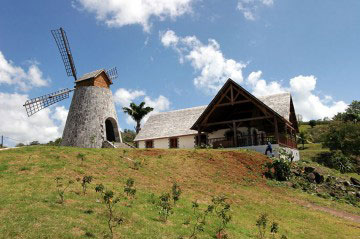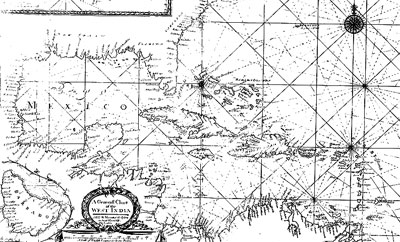|

Trois-Rivières Distillery on
Martinique. The estate was owned by the Hooke family
in the eighteenth century.
(Zananas
Martinique) |
In
July 1642, Hooke Castle was attacked by a small
Parliamentary force from the fort of Duncannon, County
Wexford. Manoeuvring two guns ashore from the ship that
had landed them, the assault party proceeded to fire on
‘the castle [for] 4 or 5 hours in vain’. Despite
warnings from the captain of the ship that ‘foul weather
was like to come upon them,’ the men were by this stage
in too great a state of disarray to effect a quick and
orderly retreat. Caught amidst ‘a very great storm and
thick mist,’ the Parliamentarians ‘could not keep
their muskets dry, nor their matches light, neither well
see each other.’ Attacked at that moment by a force of
some 200 Catholic Confederates, almost the entire party
was killed or captured. Only a small number who leaped
from the rocks into the sea, and who avoided drowning in
the attempt, made it back to the ship. Despite this
setback, subsequent attacks on the Castle were more
successful and the remaining members of the Hooke family,
the Castle’s long-time owners and residents, were
allegedly driven out by Cromwellian troops in the late
1640s, escaping or expelled to the West Indies
(O’Callaghan 1885: 328; Hayes 1949: 128).
Despite
the claims made by O’Callaghan and Hayes, no connection
can be made to substantiate a link between the Tower of
Hook (in reality a lighthouse dating from the 1100s) and
the Hooke family. While members of the Hooke family were
indeed to be found on the West Indian islands of
Martinique and Guadeloupe, it is unlikely Cromwellian
dispossession was responsible for their presence. Despite
later misconceptions, the Hookes benefited rather than
suffered from the Cromwellian conquest and settlement.
This article will examine how later accounts, reflecting
and infused with a romantic and strongly nationalist
perception of the Irish abroad, came to turn history on
its head in regard to the Hooke family. The full story is
far more complex and illustrates very well that the
reasons and motivations underpinning migration and
diasporic identity are multifaceted and subject to ongoing
change and transformation. Scholarly undertakings such as
‘The Irish in Europe’ project based in NUI Maynooth
are currently endeavouring to advance the study of the
Irish migrant experience in this context.
Some
of the confusion surrounding the history of the Hookes
stemmed from the activities of another member of the
family, Nathaniel Hooke (1664-1738). Nathaniel Hooke had a
quite remarkable life - born in Dublin, he transformed
from a radical Protestant Whig rebel fighting against
James II in Monmouth’s rebellion of 1685 to a loyal
servant of James in 1688. He metamorphosed yet again in
1701 into a diplomat and soldier of Louis XIV. [2] To suit
his changed circumstances, it seems quite likely that he
constructed this past family connection with Hook Tower.
An early seventeenth century map depicts the lighthouse as
Castle Hooke complete with fortifications (Colfer 2004:
86). A later document by Hooke refers to his possession
and use of a book of maps by cartographer John Speed
(‘The state of Scotland, written by the earl of
Lauderdale in 1690 and sent to me by M. Louis Inese,
Almoner to the Queen’ [with annotation by Hooke], 7 Nov.
1705, (A.A.E. CP Angleterre, supplemental, vol. 3, f.
277r). [3] Hooke wrote in praise of the usefulness of the
atlas in 1705, one year before he applied for
naturalisation as a French subject. For a man seeking to
prove his noble ancestry, the existence of an extant Hooke
Castle with suitably impressive battlements hinting at the
past martial gloire of the family must have been a
godsend. The naturalisation papers submitted for
registration in the Chambre des Comptes in January 1706
traced the origins of the Hookes back to Eustache de la
Hougue and the Norman invasion of England in 1066
(Bibliothèque Nationale, MSS Dossiers Bleus 59, f. 9351).
In 1172 a descendant, Florence de la Hougue, allegedly
accompanied Henry II to Ireland, established himself near
Waterford and anglicised his name to Hooke. The town which
he founded was called Hooke-Town, but unfortunately (if
perhaps conveniently), this bourg had been eventually
inundated by the ocean. The only remaining remnant of the
settlement was the family chateau, still bearing the name
of Hooke Castle. The document then skipped without further
detail directly from the twelfth century to Nathaniel
Hooke himself.
|

Anonymous, The English pilot.
describing the sea-coasts, capes, head-lands,
rivers, [...] from Hudsons-Bay to the river Amazones,
etc.
(London: Printed for John Thornton and Richard
Mount, 1698) |
A
pedigree of the family contained in a French genealogical
guide draws on and echoes much of the account given in the
naturalisation document (De Saint-Allais 1872: 19-22).
Intriguingly, however, it then proceeds to add new
information fleshing out the rather skeletal family tree
presented in the original source with a much more detailed
genealogy. In this version, we learn of the same claimed
descent from Eustache de la Hougue’s arrival in England,
to Florence de la Hougue’s journey to Ireland. From this
point it jumps four centuries to arrive at another
Eustache Hooke, of Hooke Castle, County Waterford. His
existence is unconfirmed by other documentation. He is
said to have lived in the 1590s and to have been married
to Helen O’Byrne of County Wicklow. His son is named as
Thomas Hooke (of Hooke Castle), who married Eleanor
O’Kelly from Aughrim in County Galway (or possibly of
Aughrim, County Wicklow). Partial veracity of the document
is confirmed by the inclusion of Thomas Hooke,
Nathaniel’s grandfather. Independent documentation
confirms his existence, though not his place of birth, and
the feasibility of his being born in 1590s (Twenty-sixth
report of the deputy keeper of the public records and
keeper of the state papers in Ireland 1894: 428). There is
no evidence connecting him with Hooke Castle.
It
is interesting to note that both of these early Hookes are
purported to have married women from prominent Gaelic
Irish families. Such a connection with Gaelic nobility
would have served Nathaniel Hooke’s purpose in 1706 by
strengthening his claim to noble status in French eyes. It
may also have gained him greater acceptance in Irish émigré
circles in Paris. Significantly, Hooke made no mention
that his grandfather Thomas Hooke had been mayor of Dublin
in 1654, during Cromwellian rule, nor that he had been a
lay elder of a radical Protestant church in the city.
While this would have testified to the family’s status,
it would also have highlighted unwelcome links with
Parliamentarianism and radical Protestantism in the 1640s,
1650s and 1660s. Hooke would appear to have suppressed
this aspect of his past by constructing the alternative
origin centring on Hooke Castle/Hook Tower.
Nathaniel
Hooke was far from unusual in attempting to embellish
retrospectively his ancestry, to mask the foundations of a
rather too hasty social ascent. Many first and second
generation arrivistes in Ireland, England and France spent
much time and not a little money avoiding the stigma of
being seen as a parvenu in the ranks of nobility.
‘Parvenus ... sought to cover their sometimes unsavoury
and usually shadowy backgrounds with a veneer of
antiquity’. Similarly, ‘members of the displaced élites
of Old Ireland, adrift on the continent, clutched at
pedigrees [which] comforted by reminding them of what they
had forfeited, and buttressed requests for fresh
ennoblement’ (Barnard 2003: 45-51). That even a man as
eminent in the hierarchies of the French church and state
as Cardinal Richelieu felt the need for a sympathetic
appraisal of his pedigree demonstrates that the weight of
authority and legitimacy attached to the prestige of
lineage was no mere foible (Bergin 1997: 12-13). The
consequences of having the legitimacy of claims accepted
could be great. For a man in Richelieu’s position in the
highest ranks of the elite, for example, an illustrious
past served to cast his rise to power in a natural light
and reinforce his hold on the most influential offices of
state. To those in Hooke’s position, strangers in
France, far below les grands on the social scale, the
benefits of a distinguished ancestry were more practical.
Economically, the acknowledgement of noble status was
vitally important in avoiding taxes and making the
financial position of émigré families more secure.
Socially, it provided an entrée into the decidedly and
determinedly select world of the French nobility.
|


